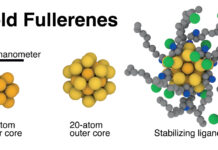
Black phosphorus is a two-dimensional material of great interest, in part because of its high carrier mobility and thickness dependent direct bandgap. However, its instability under ambient conditions limits material deposition options for device fabrication.
Here we show a black phosphorus ink that can be reliably inkjet printed, enabling scalable development of optoelectronic and photonic devices. Our binder-free ink suppresses coffee ring formation through induced recirculating Marangoni flow, and supports excellent consistency (< 2% variation) and spatial uniformity (< 3.4% variation), without substrate pre-treatment.
Due to rapid ink drying (< 10 s at < 60 °C), printing causes minimal oxidation. Following encapsulation, the printed black phosphorus is stable against long-term (> 30 days) oxidation. We demonstrate printed black phosphorus as a passive switch for ultrafast lasers, stable against intense irradiation, and as a visible to near-infrared photodetector with high responsivities. Our work highlights the promise of this material as a functional ink platform for printed devices.
Introduction
Black phosphorus (BP) is a two-dimensional (2d) material with unique optoelectronic properties. These include high carrier mobility (up to 50,000 cm2 V−1 s−1 in bulk at 30 K2) and a thickness-dependent direct bandgap, transitioning from ~0.3 eV in bulk to ~2 eV in monolayer.
These properties suggest potential applications in optoelectronics and photonics, in particular for the development of devices such as transistors, light emitting diodes, photodetectors, solar cells and all-optical switches for ultrafast lasers. Thus far, mechanical exfoliation has been the dominant production method for BP used in fundamental studies and small-scale device demonstrations.
However, the scope of this technique is limited due to low yield and a lack of control. For practical applications, a potential route is ultrasound-assisted liquid phase exfoliation (UALPE) of bulk BP crystals. This supports the production of dispersions enriched with thin (i.e. mono- and few-layer) flakes that can be exploited for their optoelectronic properties.
Provided stable dispersions can be realized, existing printing processes can be adopted for large-scale, high-speed device fabrication9. Inkjet printing is one such printing process that enables high resolution (~50 μm) maskless patterning10. Indeed, inkjet printing has been used with other 2d materials such as graphene and molybdenum disulfide (MoS2) to demonstrate novel devices, including transistors, photodetectors, and photovoltaics.
Read more: Inkjet printing of optoelectronics and photonics
PDF courtesy of: nature.com















